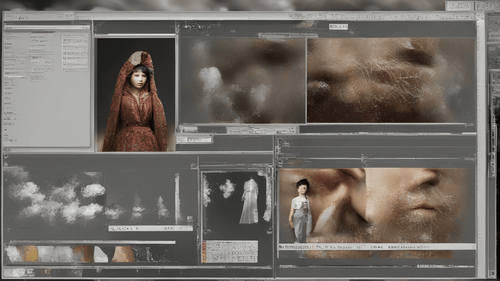
Introduction: Embracing AI for Artistic Innovation
In a world where technology continues to reshape our creative horizons, the marriage of artificial intelligence (AI) and artistic expression has ushered in a new era of possibilities. One captivating facet of this fusion is the ability to create images from AI – a process that harnesses the power of machine learning algorithms to generate captivating visual artworks that captivate the senses. This article delves into the fascinating realm of generating images through AI, exploring the intricacies, applications, and implications of this revolutionary artistic process.
Create Image from AI: Unveiling the Magic
The Science Behind AI-Generated Images
AI-generated images emerge from a symphony of complex algorithms, rooted in the neural networks that mimic the human brain's cognitive processes. These networks analyze vast datasets of existing images, learning patterns, styles, and visual elements. As a result, they acquire the ability to synthesize new images that embody the essence of various artistic genres, from impressionism to abstract expressionism.
AI as the Ultimate Creative Collaborator
Artists and creators often find themselves at the crossroads of tradition and innovation. AI offers a unique partnership – a virtual collaborator that infuses novel ideas, unconventional styles, and unexpected juxtapositions into the creative process. By leveraging AI's ability to amalgamate diverse influences, creators can unlock uncharted realms of artistic expression, fostering innovation and pushing boundaries.
Crafting Images with AI: A Step-by-Step Exploration
-
Dataset Compilation: The journey begins with the assembly of a diverse dataset that serves as AI's artistic palette. This dataset encompasses a wide spectrum of images spanning different genres, styles, and aesthetics.
-
Training the Model: Neural networks undergo rigorous training, where they learn the nuances of artistry by dissecting the dataset. This stage involves identifying patterns, textures, color schemes, and compositional elements.
-
Style Transfer: One of AI's enchanting capabilities lies in style transfer – the process of infusing an image with the visual characteristics of a particular artistic style. This technique can seamlessly meld Van Gogh's brushstrokes with a modern cityscape, creating a harmonious blend of eras.
-
Generating New Images: Once the model is adept at understanding and replicating styles, it embarks on the journey of generating new images. These artworks echo the essence of the styles learned during training, while introducing novel twists and interpretations.
The AI-Artist Confluence: Applications and Innovations
-
Art Restoration and Conservation: AI breathes new life into faded masterpieces, restoring them to their former glory. By analyzing historical data and artistic styles, AI algorithms can reconstruct missing parts of paintings, preserving cultural heritage.
-
Tailored Visual Content: Content creators, advertisers, and designers benefit from AI's ability to generate tailored visuals that resonate with specific target audiences. This personalized touch enhances engagement and connection.
-
Augmenting Architectural Visualization: AI-generated images have a remarkable knack for translating architectural blueprints into realistic visualizations, aiding architects, urban planners, and real estate developers in conveying their visions effectively.
Frequently Asked Questions about AI-Generated Images
Is AI-generated art considered authentic creativity?
AI-generated art blurs the lines between traditional artistic creation and technological innovation. While the algorithms themselves lack consciousness, they facilitate a unique form of creativity where machines interpret human-inspired patterns to craft new visuals.
What are the ethical implications of AI-generated art?
The ethical dimensions of AI-generated art touch on issues of authorship, copyright, and the role of the artist. As AI becomes more autonomous in creative tasks, society grapples with defining ownership and artistic intent.
Can AI-generated images evoke genuine emotions?
AI-generated images can evoke emotions similar to traditional art. However, the experience may differ due to the absence of a human artist's subjective intentions behind the creation. Viewers often engage with AI art in a more contemplative manner.
How can artists embrace AI as a creative tool?
Artists can harness AI as a catalyst for innovation, using it to explore new styles, concepts, and techniques. By viewing AI as a collaborator rather than a replacement, creators can integrate its outputs into their artistic narratives.
What safeguards exist against AI-generated art forgery?
The rise of AI-generated art raises concerns about forgery. Advanced watermarking, cryptographic provenance, and blockchain technology are being explored to safeguard the authenticity and provenance of AI-generated artworks.
What is the future of AI-generated visual content?
The future promises a symbiotic relationship between AI and human creators. As AI continues to refine its understanding of artistic styles and aesthetics, it will serve as an inexhaustible source of inspiration, enhancing our creative endeavors.
Conclusion: Pioneering Artistry in the Age of AI
The convergence of AI and art has given birth to an exciting chapter in human creativity. The ability to create images from AI not only redefines the creative process but also challenges our perceptions of what it means to be an artist. As we journey further into this dynamic landscape, one thing remains certain: the union of human imagination and AI's computational prowess holds the potential to create art that transcends boundaries, captivates hearts, and shapes a vibrant artistic future.
Explore the innovative world of AI-generated art at Picasso AI, where imagination meets technology to craft masterpieces beyond the ordinary.